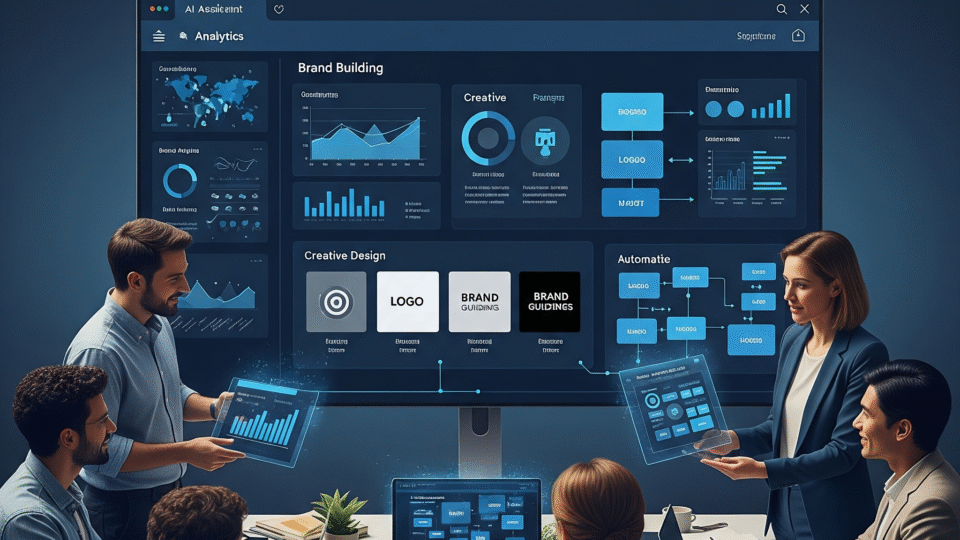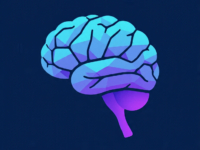
How to Use AI to Build a Brand
In today’s hyper-competitive marketplace, building a strong, memorable brand isn’t just a nice-to-have; it’s a non-negotiable for survival and growth. A brand is more than just a logo or a catchy slogan; it’s the sum total of every experience a customer has with your business, from their first impression to their ongoing loyalty. And in this increasingly digital world, the challenge of standing out and connecting authentically with your audience has never been greater.
Enter Artificial Intelligence. Far from being a futuristic gimmick, AI is rapidly becoming an indispensable tool for businesses of all sizes looking to forge powerful brands. From understanding your ideal customer at a deeper level to generating compelling content and ensuring consistent messaging, AI is revolutionizing how to build a brand. It’s about working smarter, not harder, to create a brand that truly resonates.
This article will explore the practical, actionable ways you can leverage AI to streamline your branding efforts, enhance your creative output, and ultimately, build a brand that not only attracts but retains a loyal following.
Background and Context: Branding Before the AI Revolution
For decades, brand building was an art, heavily reliant on intuition, extensive market research (often manual and costly), and creative brainstorming. Businesses would spend significant time and resources on:
- Market Research: Conducting surveys, focus groups, and competitive analyses to understand target audiences and market positioning. This was often slow and provided snapshots rather than real-time insights.
- Brand Identity Design: Working with agencies or designers to manually create logos, color palettes, typography, and brand guidelines. Iterations could be time-consuming and expensive.
- Content Creation: Manually drafting marketing copy, blog posts, social media updates, and ad creatives. This required a constant influx of human creativity and effort.
- Customer Engagement: Largely reactive, relying on human customer service teams, email marketing blasts, and generic outreach.
- Performance Monitoring: Analyzing brand health and campaign effectiveness through manual data compilation and reporting.
While these traditional methods are still valuable, they often struggled with scalability, speed, and the sheer volume of data needed to gain a truly granular understanding of modern consumers. The advent of sophisticated AI models, particularly generative AI and advanced analytics, has changed the landscape, enabling brands to operate with unprecedented agility and precision.
Key Ways AI Helps to Build a Brand
AI is not replacing human brand strategists or creatives, but rather empowering them with tools to perform tasks faster, gain deeper insights, and unleash new levels of creativity. Here’s how AI helps to build a brand across various stages:
1. Market Research & Audience Understanding
AI excels at processing vast amounts of data, offering insights that would be impossible for humans to uncover manually.
- Sentiment Analysis: AI tools can monitor social media conversations, reviews, and news articles to gauge public sentiment towards your brand, competitors, and industry trends in real-time. This helps you understand what people truly think and feel.
- Consumer Behavior Prediction: AI can analyze purchase history, Browse patterns, and demographic data to predict future consumer needs and preferences, enabling proactive brand positioning and product development.
- Competitive Analysis: Quickly identify competitor strategies, strengths, weaknesses, and market positioning by analyzing their online presence, content, and customer feedback.
2. Brand Identity & Visuals
From your logo to your overall aesthetic, AI can jumpstart and refine your brand’s visual elements.
- Logo and Visual Generation: AI-powered logo makers (e.g., Looka, LogoAI) can generate dozens of unique logo concepts, color palettes, and typography suggestions based on your industry, values, and preferred styles in minutes.
- Brand Guidelines Creation: AI can help consolidate your chosen brand elements and even suggest voice and tone guidelines, ensuring consistency across all touchpoints.
- Image and Video Creation: Generative AI tools (e.g., Midjourney, DALL-E, Adobe Firefly) can produce high-quality, on-brand images, illustrations, and even short video clips for marketing materials, social media, and website content, dramatically reducing design time and costs.
3. Content Creation & Messaging
AI is a powerful co-pilot for crafting compelling brand narratives and messaging.
- Copywriting: AI writing assistants (e.g., Jasper AI, Copy.ai, Gemini) can generate website copy, blog posts, social media captions, ad headlines, email newsletters, and product descriptions, all while maintaining a consistent brand voice.
- Content Ideation: Overcome writer’s block by using AI to brainstorm content topics, angles, and formats relevant to your target audience and current trends.
- SEO Optimization: AI tools like Surfer SEO can analyze content for keyword density, readability, and structure, helping your brand rank higher in search results and reach a wider audience.
- Translation & Localization: Break down language barriers by using AI for rapid and accurate translation of brand messages for global audiences, ensuring cultural relevance.
4. Personalized Customer Experiences
A strong brand fosters loyalty through meaningful interactions, and AI enables this at scale.
- AI Chatbots & Virtual Assistants: Provide instant, personalized customer support, answer FAQs, guide users through services, and even assist with sales queries, maintaining your brand’s helpful and efficient persona 24/7.
- Dynamic Website Content: AI can personalize website content, product recommendations, and offers in real-time based on individual user behavior, enhancing engagement and conversion rates.
- Personalized Email Marketing: Segment your audience and generate tailored email campaigns with personalized subject lines, content, and calls to action, making each interaction feel unique.
5. Brand Monitoring & Analytics
Understanding how your brand is perceived is crucial for effective management.
- Real-time Brand Monitoring: AI-powered social listening tools (e.g., Brand24) track mentions of your brand across the web, social media, news, and forums, giving you instant alerts to positive or negative conversations.
- Trend Detection: Identify emerging trends and shifts in consumer sentiment that could impact your brand, allowing you to adapt your strategy proactively.
- Performance Reporting: Automate the generation of comprehensive brand performance reports, analyzing key metrics like reach, engagement, and sentiment, freeing up human resources for strategic planning.
Detailed Comparison: Traditional Branding vs. AI-Augmented Branding
| Feature/Area | Traditional Branding Approach | AI-Augmented Branding Approach |
| Market Research | Manual surveys, focus groups, slow, static insights. | Real-time sentiment analysis, predictive analytics, deep audience segmentation. |
| Identity Design | Iterative, human-designer dependent, costly, time-consuming. | AI-powered logo/visual generation, rapid prototyping, AI-guided brand guidelines. |
| Content Creation | Manual writing/design, high human effort, slower scale. | AI-generated copy, visuals, video, rapid content ideation, SEO optimization. |
| Customer Service | Reactive, human-centric, inconsistent at scale. | Proactive AI chatbots, personalized recommendations, 24/7 support. |
| Brand Monitoring | Manual tracking, limited scope, delayed insights. | Real-time social listening, sentiment analysis, anomaly detection, automated reporting. |
| Speed/Efficiency | Slower, resource-intensive. | Significantly faster, more cost-effective, highly scalable. |
| Personalization | Basic segmentation. | Hyper-personalization at individual level. |
Pros and Cons of Using AI to Build a Brand
Embracing AI in your branding strategy comes with distinct advantages and some important considerations.
Pros:
- Speed & Efficiency: Drastically reduces the time and resources needed for tasks like content creation, market research, and design.
- Cost-Effectiveness: Many AI tools offer affordable solutions, making professional-level branding accessible to small businesses and startups.
- Deeper Insights: AI’s ability to analyze vast datasets provides a granular understanding of your audience and market trends.
- Enhanced Personalization: Delivers highly customized experiences, fostering stronger customer relationships and loyalty.
- Consistency: AI helps maintain a unified brand voice, visual identity, and messaging across all channels.
- Scalability: Allows businesses to scale their branding efforts without proportionally increasing human resources.
- Innovation & Creativity: Serves as a powerful brainstorming partner, generating novel ideas and designs.
Cons:
- Lack of True Human Nuance: While sophisticated, AI may sometimes miss subtle human emotions, cultural nuances, or highly abstract creative concepts.
- Risk of Generic Output: Over-reliance on AI without human oversight can lead to bland or unoriginal content that lacks a unique brand personality.
- Algorithmic Bias: If training data is biased, AI can inadvertently perpetuate stereotypes or misrepresent certain demographics.
- Data Privacy Concerns: Utilizing AI for personalization and analytics requires careful handling of customer data, necessitating strict adherence to privacy regulations.
- Over-reliance & Skill Erosion: Teams might become overly dependent on AI, potentially neglecting fundamental human branding skills.
- Cost of Advanced Tools: While many entry-level tools are affordable, enterprise-grade AI solutions can be a significant investment.
- Authenticity Perception: Consumers are increasingly aware of AI. Brands must be transparent and ensure AI usage enhances, rather than diminishes, perceived authenticity.
Use Cases / Who Should Use AI to Build a Brand
The beauty of AI in branding is its versatility. Almost anyone involved in building, managing, or growing a brand can benefit:
- Startups and Small Businesses: With limited budgets and resources, AI tools offer a cost-effective way to establish a professional brand identity, create marketing materials, and understand their initial audience.
- Marketing & Communications Teams: Leverage AI for content ideation, copywriting, social media management, campaign optimization, and detailed performance analytics.
- Brand Managers: Use AI for competitive intelligence, brand health monitoring, maintaining consistency, and identifying new market opportunities.
- Content Creators & Freelancers: Enhance productivity by using AI for brainstorming, drafting, editing, and generating visual assets for their clients.
- E-commerce Businesses: Implement AI for personalized product recommendations, dynamic pricing, enhanced customer service chatbots, and fraud detection to build trust and drive sales.
- Agencies (Marketing, Branding, Design): Augment their services by using AI for rapid prototyping, concept generation, and data analysis, allowing them to deliver faster and more insightful results to clients.
- Product Development Teams: Use AI to analyze customer feedback and market trends, informing product features that align with brand values and customer expectations.
FAQs about How to Use AI to Build a Brand
Q1: Can AI create a brand entirely on its own?
While AI can generate many elements of a brand (logos, copy, initial ideas), it cannot create a complete, successful brand entirely on its own. Human strategic oversight, creativity, empathy, and understanding of nuance are still essential for defining a brand’s core values, unique selling proposition, and emotional connection with its audience. AI is a powerful assistant, not a replacement for human ingenuity.
Q2: Is AI-generated content good for SEO?
Yes, AI-generated content, when properly guided and optimized, can be very good for SEO. AI tools can help with keyword research, content structuring, readability checks, and even generating SEO-rich meta descriptions. However, it’s crucial to ensure the content is high-quality, valuable, and factually accurate to avoid penalties from search engines that prioritize helpful, trustworthy content.
Q3: How can I ensure my brand’s AI-generated content sounds unique?
To avoid generic AI output, you need to provide specific, detailed prompts that reflect your brand’s unique voice, tone, and personality. Train the AI with examples of your existing brand content. Always edit and refine AI-generated content, adding your human touch, unique insights, and creative flair to ensure it stands out.
Q4: What about brand consistency when using multiple AI tools?
Maintaining brand consistency across various AI tools requires a clear brand style guide. When using different tools for different tasks (e.g., one for text, another for images), ensure you input consistent brand parameters (e.g., tone of voice, color codes, visual style prompts) into each tool. Human review is also critical to catch any inconsistencies.
Q5: Will using AI make my brand seem less authentic?
The perception of authenticity depends on how you use AI. If AI is used to automate rote tasks and free up human creativity for more strategic, empathetic brand interactions, it can enhance authenticity. However, if AI is used to produce unoriginal, bland, or misleading content, or if human connection is entirely removed, it can indeed diminish authenticity. Transparency and genuine value are key.
Q6: How do I measure the ROI of using AI in branding?
Measuring ROI involves tracking key branding metrics before and after AI implementation. This includes improvements in brand awareness (e.g., social media mentions, search volume), engagement rates, customer satisfaction scores, website traffic, conversion rates, and the time/cost savings achieved in content creation or research. Many AI tools come with built-in analytics dashboards to help track these metrics.
Conclusion: The Smart Brand’s New Edge
The question of how to use AI to build a brand is no longer theoretical; it’s a practical imperative for any forward-thinking business. AI offers an unparalleled opportunity to streamline processes, gain deeper insights into your audience, unleash new levels of creativity, and deliver highly personalized experiences at scale. It’s transforming brand building from an often intuitive, resource-intensive art into a more data-driven, efficient, and dynamic science.
However, the true power of AI in branding lies not in its ability to operate independently, but in its capacity to augment human capabilities. It’s about empowering brand strategists, marketers, and creatives to achieve more, faster, and with greater precision.
Final Verdict: Human-AI Collaboration for Brand Success
For those looking to build a resilient and impactful brand in the digital age, the verdict is clear: embrace AI as an essential partner. Leverage its analytical power for insights, its generative capabilities for creation, and its automation for efficiency. But always remember that the heart of a brand—its values, its unique story, and its authentic connection with people—still requires the indispensable touch of human empathy, creativity, and strategic vision. The most successful brands of tomorrow will be those that master the art of human-AI collaboration, using technology to amplify their human essence.



















Leave a Reply